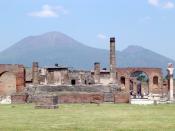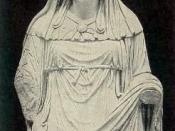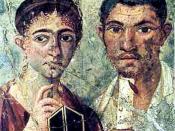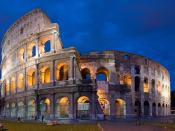This film utilizes modern technology to take the viewer back to the times of the ancient Romans by recreating the splendor of the architecture seen in the ancient times. This documentary also touches briefly on the daily life of a typical Roman, stopping for a brief minute to visit Pompeii. It is clear that the aim of this film was to inspire awe and wonder in the audience, however, one would argue that they did in fact fall very short of that mark.
This film becomes repetitive early on with its constant computer image layovers depicting what ancient buildings would have looked like. One would hope to learn more about the Ancient Romans than what their squares and monuments would have looked like. The computer generated tour around Rome had more of a feeling of a travel video than that of a historical documentary taking the viewer to the popular landmarks only to show them what a super imposed image of the 'original' building would have looked like.
This is not to say that there were not facts and tidbits thrown in for color. The viewer learns about the Vestal Virgins and how they were in fact, virgins, only to be put to death if they did on fact lose that precious title. Yet, there are historical inaccuracies which spring up within the film. It is said that the Romans were the inventors of concrete, however, upon my own research I discovered that no, in fact, the Egyptians and the Chinese had a handle on the recipe thousands of years before the Romans put it to such impressive use. This information is blatantly misleading in its inaccuracy.
In addition to the concrete faux pa, the film places an unnatural emphasis on Christianity which only appeared as a major component of Roman history in the far latter portion of the Empires tenet. In fact, an entire hour is devoted to exploring the martyrs of the religion in the Roman times, delving into miracles and saints which were early proponents of the teachings of Christ. This segment was informative and interesting, yet becomes misleading as it places such emphasis on a ideal which was not as prevalent as they would be willing to suggest.
As per the historical aspects of the city, I would much prefer the PBS Documentary The Roman Empire in the First Century as the viewer leaves with a feeling of having learned something valuable other than being able to comprehend a superimposed image of computerized structures. I became easily bored with this film and had to force myself to stop fidgeting through overlay after overlay. Overall, it seemed poorly planned and repetitive.
I would have liked to have seen more information regarding the daily life of the average Roman, or more about their commerce and structure as a society as opposed to simply the architecture. Recovered mosaics and masonry portray much to the viewer, however, an explanation from the narrator would have been helpful in deciphering such meaning.
The section about the gladiatorial games was perhaps the highlight of the film, describing how the gladiators and beasts were kept in separate rooms and corridors awaiting their fate before being sent to their death in the arena above. I will admit that this computerized image was the most helpful of all, as most modern photos only show the maze of corridors left in the arena, while this explains that at one time there was a floor of sorts above the walls and rooms.
It is truly staggering and mind blowing to think of all the exotic animals and human life which was lost in order to entertain the crowds of people. Blood sport appears to have appealed to the lowest common denominator allowing it to be the most encompassing form of entertainment in the empire. I would be curious to know whether admission was paid to enter, food was sold, or if gladiator days were considered a holiday for all, in addition to the Senators and state officials.
The film also had a section on Pompeii, which would have been very interesting and informative had the viewer never heard of the city before. The film shots and close-ups on the bodies left from the eruption of Vesuvius are legendary in their own right, however, there is more to Pompeii than the remains of the mountain's unfortunate victims. This focus runs for approximately a third of the video, continuing along the track and theme of the superimposed computer images.
I feel this film would have benefited from a wider range of information and filming techniques. The wide pans and tripod stills can become repetitive and boring when repeated over and over. Understandably, it is difficult to add a 20th century cinematic feel to structures and history long decayed and fallen, however, it would behoove the directors to add not only historical and educational interest and appeal to the film, but also aesthetic appeal as well.
All in all I found the film to be not only a disappointment but a time dragging eon of this portion of my education about Rome. Admittedly, the computerized overlays added zest and appeal to a seemingly impossible task - that of imagining what it would have looked like in the grand days of yore - yet become repetitive and stale quickly. I would not recommend this film to students learning of Rome and its history as I would not be able to justify the educational end.





